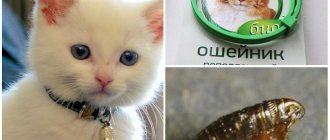If a person decides to have an animal in the house, then first of all it is important to find out what kind of care the animal requires. Cats calmly react to manipulations with a comb, many even like to bathe, but when the owner decides to trim the cat’s claws, that’s when problems begin. Even tiny kittens can become seriously angry if the procedure causes them the slightest disturbance. It is necessary to understand the animal’s fears of a procedure that is unnatural for its natural instincts. But there are objective reasons explaining why it is needed and what benefits it will bring to your pet.
It would be a mistake to approach the animal with a brave, quick step and immediately rush into battle - but a real battle will unfold for the right to wear long claws if you approach the matter at a swoop and without properly preparing the cat.
It’s good that you don’t need to discover America in this matter, and there are already ready-made working tips and detailed instructions to help you trim your cat’s claws correctly .
What's special about a cat's claws?
The cat's claws are interesting because they are retractable. Thanks to the unique structure of tendons and ligaments, nails can:
- hide when running or sneaking up on game;
- pull when jumping on prey, climbing, defending itself.
Cats mark trees with their claws to mark their territory. At the same time, they release pheromones that signal their presence to other cats. This way, when the cat is at rest, the claws do not touch the ground and wear down naturally, as in dogs.
Both wild and domestic cats need claws to walk properly. Unlike other animals, when walking they do not rely on their feet, but only on their toes. The heel does not touch the ground.
How to prepare a cat for the first procedure?
You should not trim the claws if your dog is too active and excited, as he may mistake it for violent actions, which will scare him away more. Therefore, choose a time when the kitten is calm, or better yet, when he is very tired. This way he won’t try to escape and won’t get too stressed. Remember the following rule: do not make slow movements when trimming nails, as this may begin to irritate the animal. It will begin to get nervous and break out of the owner’s hands, which will subsequently lead to damage or even injury.
Pet your pet, give him his favorite delicacy. By appeasing your pet, it will be easier for him to make contact with you, and he will be less aggressive before starting the procedure.
And most importantly, you need to talk to the animal. After all, he is also a living creature and loves when the owner speaks to him kindly.
Advice! Remember, the calmer the owner, the more obedient the animal.
So prepare yourself in advance, calm down and tune in, because an animal, even a small one, understands the feelings of its owner.
If the animal still breaks out and becomes nervous, do not yell at it. This will make him even more nervous, which will frighten the animal in the future during the next haircut.
You might think your friend is in pain during the procedure. But if you do everything correctly and at the same time without sudden or too slow movements, then your pet will be satisfied.
Do I need to trim my cat's claws?
Whether cats can have their claws trimmed depends on the pet’s lifestyle – whether she walks outside or just sits at home. In the first case, nails are needed for protection, hunting, and climbing. She won't survive in the yard without them.
When you have an indoor cat, claws grow quickly and there are no natural mechanisms to wear them down. The animal is forced to grind them off - on furniture, walls, and other objects. There is no point in punishing a cat for this - it is a reflex that cannot be eliminated. To direct your instinct in the right direction, you definitely need to buy a scratching post and don’t forget about cutting the plates.
Why trim cats' claws? As pets age, they lose activity, stop using scratching posts, and damage furniture. The plates still need to be cut off, since they will grow back, bend, and can penetrate into the pad and cause inflammation. Especially often the problem occurs with the fifth, most inconspicuous nail. The only way out in this case is surgical intervention.
Another reason why veterinarians answer yes to the question of whether cats need to have their nails trimmed. This is delamination of the plate, which leads to its breakage. Sometimes the claw can break down to the meat. In this case, the cat will be in great pain and will begin to limp.
How often is pruning done?
There are no clear deadlines for the regularity of tonsure. It all depends on the characteristics of the animal:
- claw growth rate;
- their shade: light ones grow faster;
- pet's lifestyle: active animals sharpen their claws on their own when playing.
Each owner must determine for himself when his pet needs to be trimmed. This must be done very carefully so as not to injure the animal physically and psychologically.
How can you trim a cat's claws?
Can a cat's nails be trimmed with scissors? To tidy up your paws, buy tools designed not for people, but for cats. They are more convenient to work with and the risk of injury is minimal. In addition, even the sharpest nail scissors are not suitable for cutting animal plates.
To trim a cat's claws at home, you will need:
- Plate shears or sickle or guillotine type nail clippers. Ideally, it should be a tool with stainless steel knives and handle pads that will not allow your hand to slip.
- Cotton wool or gauze in case of bleeding.
- Disinfectant (eg hydrogen peroxide).
- Gloves made of leather or thick fabric that will save your hands from scratches.
- Manicure file.
Nail trimming tools must be sharp. Before the procedure, wipe the knives with a disinfectant to avoid infection if an accidental cut occurs.
Claw clippers
When considering whether to trim your cat's nails, consider nail clippers. Give preference to the guillotine type. It is more convenient to use and cuts plates better. The sickle-shaped tool is intended for animals whose claws are stronger than those of a cat.
What you need to trim nails
To cut cat claws, you need to choose the tool that is most convenient for you, so that it removes excess quickly and painlessly for your pet. You can buy several types of tools to understand exactly which one you intend to use in the future. Since the cat has as many as 18 toes, you can try each type in action.
There are several variations of devices:
- Nail Scissors – The scissors you use to trim your nails should only be used on your teenage kitten's delicate claws. For an adult cat, it is better to have a separate tool, designed taking into account the anatomy of the claw structure.
- Manicure tongs are convenient for removing the tips of claws.
- Blister nail clipper (specialized scissors designed for cats) is an affordable tool that is easy to use.
- Guillon trimmer - this tool can cope with thick claws of the hind paws, the disadvantage of using it is that it is difficult to see which part of the claw will be cut off.
You can choose what is more convenient for you to work with, however, it is preferable to use a blister or guillotine trimmer, because these tools are specially selected for a thick cat's claw.
Additionally, for comfortable nail trimming you may need:
- a piece of cotton wool or a cotton pad;
- hydrogen peroxide;
- hard manicure file;
- a machine for cutting hair (if the cat is too fluffy, this will help remove the hair between the fingers).
At what age should a kitten's nails be trimmed?
Is it possible to trim kittens' nails? Yes, but not for newborns. Small cats do not know how to remove their claws. They are constantly released and spread out. They use marigolds from the first days of life, massaging their mother's nipple with their paws to stimulate milk synthesis. At first the claws are soft and short, then they begin to harden and by 6-8 weeks they leave the first scratches.
When can you trim a kitten's nails? Not earlier than 3 months. The plates harden completely by 6 months. By this time, the kitten can already be accustomed to the procedure.
Why does a kitten need nails?
It’s clear why cats living outside need claws. And to escape from danger, and to feed. Why does a pet need them? He doesn't leave the apartment. And he has no idea what hunting is. Maybe you shouldn’t bother with the question of at what age can a kitten’s nails be trimmed? How about taking the baby to the veterinary clinic and getting rid of this sharp weapon?
So we get to the main idea. Claws are a cat's weapon. They are also compared to human fingers. It is the claws that help animals sense balance and play an important role in the pet’s spatial orientation. It has long been known that cats that are deprived of this important addition to their paws become “crippled.” Their musculoskeletal system is impaired.
How to trim a kitten's claws correctly
The sooner you start accustoming your cat to trimming its claws, the fewer problems will arise during the procedure. It is important that the first manipulation goes smoothly, without pain or discomfort, otherwise the cat will resist in the future.
How to trim a kitten's claws at home: precautions
Before you start cutting the plates, you need to find out how a kitten’s nail works. It consists of 2 parts - keratinized and living (pulp), where nerves and blood vessels are located. The pulp looks like a dark or pink formation. If you touch it while cutting the plates, the cat will be in pain, will bleed, and will not voluntarily agree to a repeat procedure. Therefore, cutting nails must be approached carefully and carefully.
Step 1. Prepare the kitten mentally
Claw trimming needs to be taught carefully. Both you and the kitten should be calm during the procedure. It is advisable for the pet to be relaxed and even sleepy (for example, after eating). Take other animals from the room - cats, dogs, birds. To prevent your cat from reacting to pigeons, close the curtain.
Step 2. How to trim a cat's claws: train the paw to be petted
Sit on a chair in a quiet, quiet room with the kitten on your lap. Start stroking him, paying attention to his paws. Gently touch each pad. Do not squeeze or pinch the paw. The pet should get used to the fact that you often caress its legs. You can also stroke it behind the ears and in other places where the cat likes it.
Apply gentle pressure to the pad so that the nail comes out. Then lower your paw and give your baby a treat. After some time (preferably the next day), repeat this with the other finger. Do this until you have worked on all the claws.
Step 3. Trimming claws: introduce your pet to the tool
The cat should respond calmly to the clicking sounds of the scissors. Periodically hold the tool in your hand and click close to it. Do this until the cat stops reacting to it.
Step 4. How to trim a cat’s claws yourself: step-by-step instructions
- Place your pet on your lap. Take the paw with one hand and the nail clipper with the other.
- Start massaging the paws, pressing on the pad to stretch the claws.
- Select one finger and carefully examine it to determine where the pulp ends.
- Where to trim cats claws? You only need to cut off the white part of the plate, no less than 2 mm from the pulp. If you are cutting for the first time, you can increase the distance even more and cut it off a little.
- How to trim a cat's claws with a nail clipper? Hold the pliers perpendicular to the plate. If they are placed parallel, the nail may separate.
- To smooth the tip, you can use a nail file.
- As soon as you trim 1 claw, reward your cat with a treat.
- Never cut more than 2 plates at one time - it will be uncomfortable for the cat.
- At first, treat not two, but 1 paw.
- If you accidentally injure your pet, use a cotton swab to stop the bleeding.
Preparing for a haircut
An animal experiences stress when its owners start something “against” it. It’s worth starting with preparatory procedures, and preferably from infancy. Adult animals are reluctant to change. Without preparation, the cat may be injured.
The right moment is chosen for a haircut. The cat should be free from business: food or games. The animal is picked up and gently stroked, so the pet relaxes. Slowly, from stroking the back and head, the owner moves on to the cat’s paws - stroking and massaging them.
The main thing is that the cat’s attention should be scattered - it should not break out or suspect something is wrong.
You need to allocate 2-3 days for preparatory procedures. When you touch their paws, you will notice the cat's irritation - they do not like their paws being touched. If you regularly repeat the procedure, the growing kitten will get used to it, the main thing is to provide an “anchor” for it in the form of a treat after the process.
After the kitten gets used to touching, the next stage begins - imitation of a haircut:
- the kitten is placed in a suitable position;
- touch the animal on different paws;
- inspect the claws and press on the pads.
After the procedure, the kitten will be grateful if his patience pays off with treats. The kitten also gets to know the nail clipper for the first time - he must understand that the tool will not harm him. When he begins to accept it calmly, you can get a haircut.
How to trim a cat's claws if she's struggling
Do cats need to have their nails trimmed if they don't like the procedure? Before trimming an aggressive cat's nails, swaddle her in a towel. And only then treat your nails. This will protect both you and the animal from injury. Do not shout or punish your pet - this will make the situation worse. Speak in a soothing, gentle voice.
You can also contact a specialist, but keep in mind that with him she will resist more. There is a high probability that he will not be able to calm your pet and trim the plates efficiently.
What to do when the animal is not given?
Pets have different temperaments. There are aggressive and nervous cats. They are unlikely to allow their nails to be trimmed in peace. Most likely, the animal will scratch, bite, and break out.
If the cat does not give in, you cannot show force: this can injure its paws. It is advisable to perform the procedure by two people: one holds, the other trims the claws. You can also swaddle your pet or wrap it in a blanket.
If he is very nervous, it is better to refuse the event and do it when the animal is more pliable and balanced.
Where is the best place to trim a cat's claws?
If you are afraid of injuring the kitten, cutting off the plate incorrectly, you can trim the cat’s claws at a veterinary clinic or at a groomer. It is better for a specialist to come to your home, especially if you do not have vaccinations. In a familiar environment, the animal will feel calmer and less distracted.
If the specialist only works in the clinic, buy a carrier to take the cat there. Otherwise, the animal may escape along the way.
In order not to constantly call a specialist, ask him to show you how to properly cut the plates. The first few times, do the procedure under his supervision. Then handle it yourself.
Nail trimming and breed
At what age can you cut the nails of a Scottish, Siamese or Persian kitten? In fact, nothing depends on the breed here. It all depends on the age of the animal. Claws are formed in felines by the age of 4-6 months. It is during this period of time that owners begin to prune them.
Do I need to take my pet to the veterinary clinic for this? If the owner is very afraid to perform the procedure on his own, then it is possible. But there is nothing complicated about this manipulation. Below we will tell you in detail how to trim your pet's claws.
Useful tips
- Never trim the plates if the cat is agitated or upset.
- Take your time during the procedure. One awkward movement can lead to injury, injury, or frighten the animal.
- Do not try to treat 2 paws at once, especially when you are just accustoming your pet to the procedure.
- Don't forget about the claw on the 5th finger. If it grows into the skin, it will be very painful for your pet.
- Don’t forget to praise the cat after trimming each claw and give a treat at the end of the procedure.
- Should a cat's back claws be trimmed? Yes, but not as often as the front ones. The back plates grow more slowly.
What is required for a haircut at home?
A set of necessary tools:
- Hemostatic agent. This could be flour, baby powder, or hydrogen peroxide in case you hit a live part of the nail and your dog bleeds.
- A nail file is needed to remove irregularities, sharp corners and nicks after cutting.
- It is better to purchase a special nail clipper at a pet store or grooming salon.
- Cotton pads.
- Pet treat. Be sure to reward him if he behaved well during the procedure.
IMPORTANT!
Under no circumstances cut your dog’s nails with regular scissors, otherwise you will not only injure him, but also scare him.
Then cutting will become a real problem.
Is it necessary to remove claws?
Don't remove the claws! During onychectomy, not only the plate is removed, but also the phalanx of the finger from which it grows. Only a very young cat can survive surgery without consequences, and the procedure itself carries many risks.
Among them:
- blood loss;
- infection;
- nerve deformation;
- disturbance of gait, balance, coordination due to the fact that the pet will be forced to step on the pad and not the fingers;
- deterioration of character due to the fact that the cat feels vulnerable and unable to defend itself.
Instead of removing the plate, trim it regularly, use a scratching post. If you don't have time to trim, buy soft silicone covers for cat nails. As the plates grow, they come off (after 2-4 weeks), and the procedure must be repeated. During this time, the claws become soft and dull, and therefore the cat will not be able to damage the furniture with them.
When can you start cutting your newborn's nails for the first time?
One of the first questions that a young mother has when caring for her baby is how long after birth can she cut her newborn’s nails?
?
As soon as the baby is born, the edges of his nail plates do not separate from the skin, as they are quite soft. This is why you should not cut a newborn’s nails in the first two weeks - to avoid skin damage and, as a result, a possible inflammatory process. To prevent the child from scratching himself during this period, it is recommended to wear special mittens.
A month after birth, you can safely start cutting your baby’s nails.











